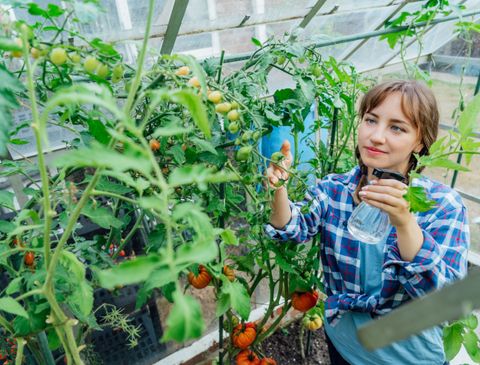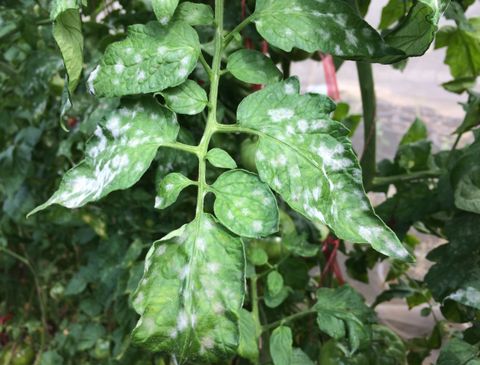Tired of that powdery mildew on those tomato plants every season? Don’t worry, there are a few ways to save those plants before the fungus spreads!
KEY TAKEAWAYS
- Spacing tomato plants 2 to 4 feet apart and pruning low-hanging leaves can help prevent powdery mildew by increasing airflow and decreasing moisture.
- Using conventional fungicides every 7 to 14 days before infection occurs can help prevent the spread of the fungus on tomato plants.
- Constant air circulation, achieved through staking and tying tomato plants, can help kill the fungus and prevent powdery mildew from developing and spreading.
When the warm season rolls around, gardeners already have an idea of the fruit and vegetables they want to grow throughout the spring, so they’re ready for harvest by summer. One of the more popular fruits to grow are tomatoes. Because of their bountiful harvest, tomatoes are the perfect first crop to grow at home.
The downside to growing tomatoes is that they’re victims of powdery mildew that coats the skin or attacks the leaves. This mildew is a fungus, and because fungi love humidity and a moist environment, tomatoes can be affected as the fungus travels via the soil or wind.
The fungus starts as yellow spots on leaves before turning white (looking like baking flour). Plants that are stressed and aren’t taken care of properly are more susceptible to getting this fungus, but is there a way to protect home-grown tomatoes and keep the fungus at bay? Yes! There are a few easy ways to keep that evil mildew away.
Space and Pruning

The best way to prevent the white powdery mildew on tomato plants is to start at the beginning when planting. Because this fungus enjoys humidity and close quarters, spacing tomato plants about 2 to 4 feet apart is best. By spacing them 2 feet apart – and rows 4 feet from each other — the plant gets more natural light (at least six to eight hours of full sun) and oxygen. Therefore, decreasing moisture and powdery mildew.
Once the tomato plant starts growing branches and sprouting leaves, it’s important to focus on the foliage closest to the soil. Because fungus cells start in the soil, the spores can easily attach to low-hanging foliage or branches. By pruning the low-hanging leaves, it decreases the chances of the fungus growing up the plant.
Conventional Fungicides

If a gardener needs help keeping the white mildew away from their plants, choosing conventional fungicides can be prudent. Fungicides will not cure a plant after its infection, but a gardener can prevent disease by spraying fungicides every 7 to 14 days before the likeliness of illness begins.
Before buying a fungicide, make sure that it’s safe for tomatoes and follow the instructions for how much fungicide to spray. When tomato plants are 10 to 12 inches tall, spraying the fungicide is encouraged. While gardeners can spray the fungicide on the plant, they can also mix it with one gallon of water for better coverage. You can continue spraying the plant throughout the growing season (March through September). Spraying the fungicide before infection occurs is the best way to avoid it altogether.
Improve Air Circulation

To kill the fungus, tomato plants need constant air circulation. Circulating air can start as early as planting the seeds. By staking the plant, it will have enough space from other plants for air circulation and the ability to grow, and it won’t be too low for the soil to be compromised by disease.
Using a stake, a gardener should place it about 6 to 12 inches into the ground before tying the plant loosely to the stake. As the plant grows taller, continuing to tie it to the stake will make space for ventilation, while the plant gets ample sun (at least six hours a day) and space from other plants. Proper airflow will help keep powdery mildew from developing and spreading.
Get Rid of Diseased Plants

To ensure the white mildew on tomato plants doesn’t spread, it’s best to get rid of the infected plant. Moisture on leaves only helps spread the spores more. If fungicides weren’t used or the mildew spread too rapidly, it’s best not to eat the tomatoes and destroy the plant before the mildew rips through the garden.
Dig the tomato plant out of the soil and toss it in the garbage or burn it instead of composting it. Composting the diseased plant only further spreads the disease into whatever is being composted, thus infecting new soil before a tomato plant can even get started safely.
Try Approved Natural Oils

Multiple different fungi diseases can infect tomato plants. If the powdery mildew is in small amounts and hasn’t infected the entire plant, horticultural oils can be the way to go. Oils like Saf-T-Side Spray Oil, neem, or Sunspray Ultra-Fine Spray Oil can be a huge help. It should be noted that oils shouldn’t be applied if the plants are in distress from heat above 90 degrees Fahrenheit or are in a drought.
The oil can wind up burning the leaves when interacting with the sun, thus stressing the plant all the more. The best time of day to apply oils like neem is at dusk or early evening to avoid possible burns.
While Saf-T-Side Spray and Sunspray Ultra-Fine Spray should be used as directed, natural oils like neem and jojoba differ. If using neem (which can also defer insects), gardeners can add 2½ Tbsp. per gallon of water and spray the plant and the soil every 7 to 14 days. It’s important to remember the undersides of the leaves as well!








